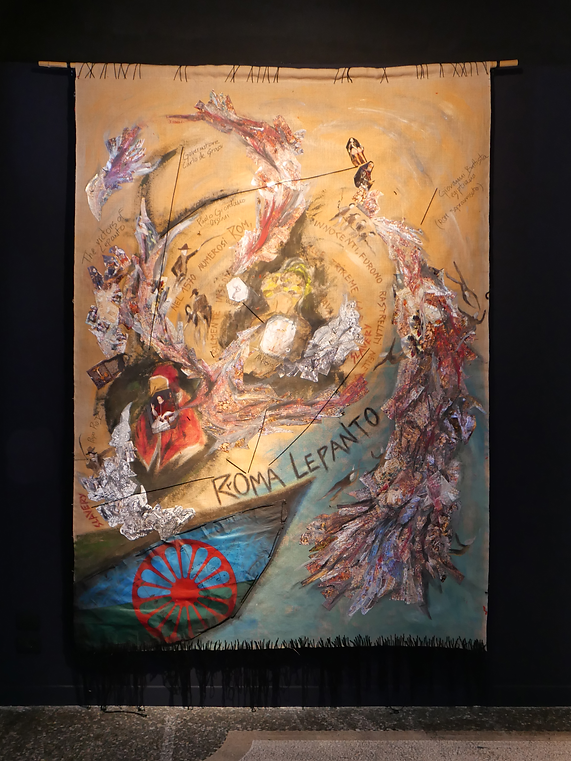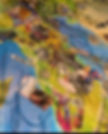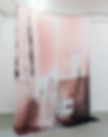
Rʳoma Lepanto
Mix media on fabric, 210x300cm, 2024
In the collage Rʳoma Lepanto, I explore the historical context of discrimination against Roma*, the complexities of religious and ethnic tensions and their lasting impact on contemporary society and conflict dynamics .
In the aftermath of conflicts such as the Battle of Lepanto and amidst the religious and political tensions of the time, minority groups, including the Roma*, were often caught in the crossfire or taken as scapegoats.
Through the use of images, threads and collages, I have attempted to tell the story from the point of view of the Roma* and Italians and, above all, highlighting how the legacy of historical events such as the Battle of Lepanto serves as a reminder of the complex interplay between religion, ethnicity and power dynamics in shaping human history and contemporary social challenges.
photo by: Moritz Pankok

Megaphone
Mix media on fabric, 2024
Megaphone, through the shape of a flag, wants to represent the silent scream of the intersections of poverty and marginality. Once again, De Rosa collected photos from various racially biased online newspapers, mostly Italian, depicting the degradation of Roma* and Sinti* living in conditions of extreme social marginalisation. Through the collage, she wanted to present the way in which Roma* are projected and deceived by mass visualisation and at the same time to depict a kind of map of how poverty links with important issues such as early marriage, eraly motherhood and school drop-out among young Roma*.
photo by: Jeremy Knowles

Spaces of Misunderstandings
Performance, wool, peppers, sunflowers, texile, toilet paper, toilet for camping, 2023
The performance “Spaces of Misunderstandings” through music and storytelling, takes its cue from the idea of being women, Italians with Roma backgrounds, who require housing and from different political identities, addressing gender, racial and cultural discrimination in the media and urban (or city/nation) space from feminist and intersectional perspectives and critiques.
Invoking a space that through writing, textiles and objects recalls the idea of a bathroom, the artist reflects on the meaning of nomadic camps, belonging to an ethnic minority, trauma and mental health problems of racialized people, accompanied by remixes of some songs by Pauline Oliveros, Nana Vasconcelos, the Roma anthem sung during a protest in Milan, and part of an oral poem by a Romni (Roma woman) from Czech Slovakia, Tera Fabiánová.
Through storytelling, De Rosa invokes the idea of an in_visible archive, blowing into small bottles that contain only air and suspending them in a curtain made of peppers, as a symbol of keeping evil eyes away.
Photo by: Jana Kießer

Jaćh opràlë lë làvë miré,
Performance, as part of the event BAMSM (Black Arts Movement School Modality)
curated by Romi Crawford and co-curated by Mackda Ghebremariam Tesfaù at the MUDEC, Milan, IT, 2023
The performance "Jaćh opràlë lë làvë miré" goes to explore the notion of Deep Listening by creating and experimenting with sonic-temporal spaces. Listening is a political act, especially in an age of the omnipresence of images and the monopolization and centralization of the visual.
The question has never been whether one can or who can speak, but rather who can listen.
Jaćh opràlë lë làvë miré explores how stories of the past and present can be conveyed through sonority-including narratives through identifiable or unidentifiable vocal utterances, speech, sound, and music of all genres and subjects. When auditory experiences are shared, stories are also shared, not only from mouth to ear, but are fully perceived by mouth and ear, felt and encoded in the body through the physicality of sound waves, and transmitted from one generation to the next. The history of brutality against people on the basis of their ethnicity, racial affiliation, gender, sexual orientation, class, migrant status, or simply because of the sheer exercise of sovereignty power over citizens is a long history that has been extensively explored visually and in writing. But how does it sound?
Through poems , manifestos and stories by Romnia, such as Jelena Savic, a writer, activist, queer Roma from Belgrade, whose poems are not even recognized as typical Roma poems, as they present feminist issues, power relations, violence, social justice and even theoretical aspects, playing with language, genders, philosophy, etc.
Or by Mariella Mehr, Romni from Zurich, who was separated from her mother at an early age and placed under guardianship. She grew up with foster parents and in mental institutions. When she became pregnant at the age of 18, she was placed in so-called "administrative care" for 19 months in the Hindelbank women's prison. She belongs to the third generation of her family who were victims of the "relief organization." Her poems are very diverse in both form and content; some of them reveal a tentative search for something, a quest.
The performance also features fragments of poetry by Papusza (1908-1987), a Polish Roma woman who learned to read and write by stealing chickens and exchanging their corpses for books and lessons! In the summer of 1949, Jerzy Ficowski heard Papusza perform her songs and, recognizing her talent, urged her to write them down as poems for publication. The song "Tears of Blood," along with many others, was published by Ficowski in the early 1950s in a book called Pieśni Papuszi (Papusza's Songs). The poems were written in romanés. Most of his works dealt with nostalgia, longing and (especially) feelings of loss. The Romani community soon began to regard Papusza as a traitor, threatening her and calling her names, both for revealing details about Romani language, culture, customs, and common law, her contacts with gadjos (non-Romani people), and her alleged role in the government's anti-Nomani moves.
During the performance, the use of the thread and the gesture of exchanging it by knotting ourselves in this exchange is a metaphor for how society "sews" prejudices and imagined identities, but also how our stories are woven together as a thread of what is a hidden past and an existence of resistance, survival, and resilience.

Dikchaw daj, dikchaw doj
collage, wool, oil on canvas, 3 h x 1.65 w, 2023
The collage explores the histories, memories and various occupations of a number of Roma, Sinti and 'Camminanti' communities in Italy, from those of ancient settlement, such as the Abruzzi and Molise Roma, present in Italy since the 15th century and arriving from Greece and Albania, to the Khorakhana (Muslim) and Kanjarja (Orthodox) Roma, who arrived after the war in Yugoslavia, or the 'Camminanti' who reside mainly in Noto in Sicily.
Nomadism, asociality and re-education become the three cornerstones around which the public discourse in Italy on the so-called 'gypsy problem' revolves with a view to its final resolution.
The title Dikchaw daj, dikchaw doj (I look here, I look there) takes its cue from a poem by Papusza, (1908-1987), a Polish Roma woman, who describes the fate of her nation, expressing her habits and yearnings, so the collage, through painting, photos and writing, recounts the multi-layered nature of identities and the notion of intersectional discrimination in which these identities are inseparable from each other. The collage aims to urgently challenge misunderstandings and stereotypes and at the same time give an insight into immigrations in Italy, in order to share reflections and be involved in social change, creating new narratives and above all radically rethink the way we live together on this planet.

The Structure of Antigypsyism
collage, wool, oil on canvas, 3 h x 1.65 w, 2022
In this collage, multimedia and multi-materiality represents the complex and multifaceted character of anti-Gypsyism, which manifests itself in the pejorative stereotypes projected onto European Roma communities.
This collage does not attempt to provide a new explanation of the historical roots of anti-Gypsyism. Rather, it has a strong common thread that allows us to highlight the resilience of Romani populations throughout history.

Cosa vuol dire essere Romnia?!
Performance
Villa Romana, Florence, 2022
Through poetry and writing, the performance aims to raise awareness and valorise the role and multiple identities of Roma women. The use of the thread, refers to the idea of how society 'sews' prejudices and imagined identities onto those who are perceived as 'other', but also how our stories intertwine as a thread of what is a hidden past and an existence of resistance, survival and resilience.

Cosa vuol dire essere Romnia?!
Lecture performance
Polo Museale S.Spirito, Lanciano, 2022

Il Manifesto delle Romnia
Oil colours and markers on silk, black wool, 120x70cm, 2022
Our body is not a biological datum, but an inscription field of socio-cultural codes
Warriors of the post-patriarchy
We are a multiple diversification of this subjectivity... ROMNIA...
We cannot bear silence
We are here, queer, women, mothers, open, fluid, virtual
ready to be seen with our own true biographies and identities

Sullo spigolo dei silenzi
series of 60 pieces - photos on silk ,120x140cm each, 2017 on going
The series Sullo spigolo dei silenzi "On the Edge of Silences" tells how race, ethnicity, as well as gender are socially constructed categories, imagined and invented by the society. The omnipotence of digital media and social networks commodifies every body and at the same time intensifies structural differences and inequalities through access to the technologies that really drive the market.
Collecting the stories of queers, of multiple and indefinite identities who live their sexuality as a defect or as a psychological problem dictated by public opinion, I took pictures of parts of their bodies making them indefinite, and then printed on a semi-transparent silk from which you can see both sides and then sew them together as a metaphor for the violence and exclusion dictated by society against those who are perceived as "other".
Photo by: Jana Kießer

Social Atmosphere
collage, painting 70x50cm, 2022
10 years after the Roma and Sinti memorial in Berlin, the collage covers various political and social issues of recent years. From the pandemic, to the various forms of racism, as well as the various protests that have marked an important change; from the explotation of refuges and Italian nomad camps to the figure of the Roma woman who wants to be recognised in her true biography.
The collage leaves open the reflection of a past, a present and an uncertain future.


Roma Camps in Italy - the architectural expression of state racism
Collage, photos, oil paint, 60x42cm, 2022
The camp is the place where those perceived as different are confined, a technology of power and at the same time a device of governance. The 'nowhere', the 'non-place', where those who are considered "humanities of excessis" are relegated. The camp is the place where subjects, having lost their individuality, harnessed to massifying bureaucratic categories, redefine themselves on the basis of these same practices and categories. In this collage I have collected photos of different nomad camps from various Italian online newspapers that use racist articles to illustrate the degradation of people living in extreme social marginalisation.
Foto by: Jana Kießer

Romnjadigitalised
Collage, oil painting, 47x57cm, 2022
The collage explores issues of Roma identity and feminility and the politics and poetics of its visual representation. Creating through intervention with paint, dense images that almost metaphorically follow the friction and conflicting realities of ideas related to being an artist, Roma and woman in search of a way to exist in between, to be multiple, to remain irreducible.

Cosa vuol dire essere Romnia?!
oil on canvas, wool, 120x140cm , 2022
Part of a series that through the use of different media explores the possible interpretations, political identities and visibility of the bodies of real and imagined Roma women.

Über Land Gehen
oil on canvas, 130 x 153cm, 2022
The painting depicts faceless bodies moving in a dreamy landscape on a boat in search of somewhere to go.
Dedicated to those lost on the Mediterranean route.

The Drowned World
Installation - Performance, various materials
Bregenz, 2019
Borrowing the title from J. G. Ballard's apocalyptic novels from 1962, the performance "The Drowned Word" symbolically activates a drinking trough for cows connecting it to the ambiguous meaning of ‘well poisoning’, an age-old form of terror as well as a pretext to falsely blame foreigners and ethnic minorities.
The performance took place shortly after the European elections at the height of Matteo Salvini's racist campaign against immigrants.
A body floats in black putrid water–– black from hatred, indifference and contempt.
Fragilità Ermetica
Installation – Performance
bubble wrap, wood, mirrors, honey
Spazio Cut, Milan, 2018
Fragilità Ermetica (Hermetic Fragility) is a dreamlike, dreamy, alienating reality, that distances us from all previous convictions and leaves us in complete silence, doubt. The current policies and rhetoric of exclusion, refoulement and identification for Roma, migrants and asylum seekers unfortunately remind us that the stakes are not only military but also biological.
Our identity has taken on a thousand nuances and our body, enclosed and sealed in a space, as in a cocoon, awaits a transformation, a change.

Performance - Installation
San Carpoforo, Milano , 2017
The term Mnemosyne comes from the Greek and means remembrance, memory.
In this performance I am wrapped in bubble wrap, which packs and protects me at the same time. The mask I wear in a theatrical way hides me from a thousand or no identities and in the meantime a video projecting molecules and blood cells is projected onto my body.
As people become part of the performance, I invite them to wear a mask that cheers me up to feel part of a social theatrical fake.
